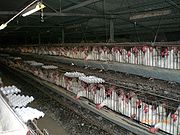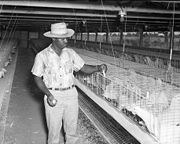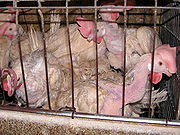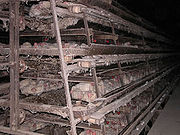
Battery cage
Encyclopedia

Poultry farming
Poultry farming is the raising of domesticated birds such as chickens, turkeys, ducks, and geese, for the purpose of farming meat or eggs for food. According to the Worldwatch Institute, 74 percent of the world's poultry meat, and 68 percent of eggs are produced in ways that are described as...
, battery cages (often called factory farming
Factory farming
Factory farming is a term referring to the process of raising livestock in confinement at high stocking density, where a farm operates as a factory — a practice typical in industrial farming by agribusinesses. The main products of this industry are meat, milk and eggs for human consumption...
in the United States or battery farming in the United Kingdom) are an industrial agricultural
Industrial agriculture
Industrial farming is a form of modern farming that refers to the industrialized production of livestock, poultry, fish, and crops. The methods of industrial agriculture are technoscientific, economic, and political...
confinement system used primarily for egg-laying hens
Chicken
The chicken is a domesticated fowl, a subspecies of the Red Junglefowl. As one of the most common and widespread domestic animals, and with a population of more than 24 billion in 2003, there are more chickens in the world than any other species of bird...
. The battery cage has generated controversy among advocates for animal welfare and animal rights
Animal rights
Animal rights, also known as animal liberation, is the idea that the most basic interests of non-human animals should be afforded the same consideration as the similar interests of human beings...
and industrial egg producers.
It is estimated that over 60% of the world’s eggs are produced in industrial systems, mostly using battery cages, including over three quarters in the EU.
History

Original battery cage were an extension of the technology used in battery brooders, which were cages with a wire mesh floor and integral heating elements for brooding baby chicks. The wire floor allowed the manure to pass through, removing it from the chicks' environment and eliminating manure-borne diseases.
Early battery cages were often used for selecting hens based on performance, since it is easy to track how many eggs each hen is laying if only one hen is placed in a cage. Later, this was combined with artificial insemination, giving a technique where each egg's parentage is known. This method is still used today.
Early reports from Arndt about battery cages were enthusiastic. Arndt reported:
"This form of battery is coming into widespread use throughout the country and apparently is solving a number of the troubles encountered with laying hens in the regular laying house on the floor.
In the first edition of this book I spoke of my experimental work with 220 pullets which were retained for one year in individual cages. At the end of this year it was found that the birds confined in the batteries outlaid considerably the same size flock in the regular houses. The birds consume less feed than those on the floor and this coupled with the increased production made them more profitable than the same number of pullets in the laying house.
A number of progressive poultrymen from all over the United States and some in foreign countries cooperated with me in carrying on experimental work with this type of battery and each and every one of them were very well satisfied with the results obtained. In fact, a number of them have since placed their entire laying flocks in individual hen batteries."
The use of laying batteries increased gradually, becoming the dominant method somewhat before the integration of the egg industry in the 1960s. The practice of battery cages was criticized in the book Animal Machines, published in the 1960s.
In 1990, North and Bell reported that 75% of all commercial layers in the world and 95% in the United States were kept in cages.
By all accounts, a caged layer facility is more expensive to build than high-density floor confinement, but can be cheaper to operate if designed to minimize labor.
North and Bell report the following advantages to laying cages:
1. It is easier to care for the pullets; no birds are underfoot.
2. Floor eggs are eliminated.
3. Eggs are cleaner.
4. Culling is expedited.
5. In most instances, less feed is required to produce a dozen eggs.
6. Broodiness is eliminated.
7. More pullets may be housed in a given house floor space.
8. Internal parasites are eliminated.
9. Labor requirements are generally much reduced
They also cite disadvantages to cages:
1. The handling of manure may be a problem.
2. Generally, flies become a greater nuisance.
3. The investment per pullet may be higher than in the case of floor operations.
4. There is a slightly higher percentage of blood spots in the eggs.
5. The bones are more fragile and processors often discount the fowl price.
Disadvantages 1 and 2 can be eliminated by manure conveyors as pioneered by Arndt, but some industrial systems do not feature manure conveyors.
In general, farmers and poultry scientists who have used both floor confinement and cages do not seem to have felt that cages were either ineffective or inhumane, though there was considerable criticism of individual installations that were too expensive or were poorly designed to yield the all-important reduction in labor inputs.
European Union
Battery cages are due to be banned in the European UnionEuropean Union
The European Union is an economic and political union of 27 independent member states which are located primarily in Europe. The EU traces its origins from the European Coal and Steel Community and the European Economic Community , formed by six countries in 1958...
from 2012 after a 10-year phaseout, to be replaced by "enriched
Furnished cages
Furnished cages, sometimes called ‘enriched’ or ‘modified’ cages, are cages for egg laying hens which have been designed to overcome some of the welfare concerns of battery cages whilst retaining their economic and husbandry advantages, and also provide some of the welfare advantages of non-cage...
" or "furnished
Furnished cages
Furnished cages, sometimes called ‘enriched’ or ‘modified’ cages, are cages for egg laying hens which have been designed to overcome some of the welfare concerns of battery cages whilst retaining their economic and husbandry advantages, and also provide some of the welfare advantages of non-cage...
" cages. The 1999 EU Hens Directive bans the conventional battery cage from 2012. In their 1996 report, the European Commission's Scientific Veterinary Committee (SVC) condemned the battery cage, concluding:
"It is clear that because of its small size and its barrenness, the battery cage as used at present has inherent severe disadvantages for the welfare of hens".
The EU Hens Directive allows enriched cages to be used. Under the directive, enriched cages must be at least 45 cm high and must provide each hen with at least 750 cm² of space; 600 cm² of this must be "usable area" – the other 150 cm² is for a nest-box. The cage must also contain litter, perches and "claw-shortening devices". Some animal welfare organisations, such as Compassion in World Farming
Compassion In World Farming
Compassion in World Farming is a campaigning and lobbying animal welfare organisation, with headquarters in the UK, branches in eight European countries and international representatives in China, Australia and South Africa...
, have criticised this move, calling for enriched cages to be prohibited as they believe they provide no significant or worthwhile welfare benefits as compared with conventional battery cages. The use of battery cages is banned in Belgium
Belgium
Belgium , officially the Kingdom of Belgium, is a federal state in Western Europe. It is a founding member of the European Union and hosts the EU's headquarters, and those of several other major international organisations such as NATO.Belgium is also a member of, or affiliated to, many...
, Austria
Austria
Austria , officially the Republic of Austria , is a landlocked country of roughly 8.4 million people in Central Europe. It is bordered by the Czech Republic and Germany to the north, Slovakia and Hungary to the east, Slovenia and Italy to the south, and Switzerland and Liechtenstein to the...
, Sweden
Sweden
Sweden , officially the Kingdom of Sweden , is a Nordic country on the Scandinavian Peninsula in Northern Europe. Sweden borders with Norway and Finland and is connected to Denmark by a bridge-tunnel across the Öresund....
and the Netherlands
Netherlands
The Netherlands is a constituent country of the Kingdom of the Netherlands, located mainly in North-West Europe and with several islands in the Caribbean. Mainland Netherlands borders the North Sea to the north and west, Belgium to the south, and Germany to the east, and shares maritime borders...
.
Germany
Germany has prohibited enriched cages from 2012. Germany has also banned conventional cages from 2007, five years earlier than required by the EU Directive. Mahi Klosterhalfen of the Albert Schweitzer Foundation has been instrumental in strategic campaign against battery cages in Germany.Switzerland
Battery cages have been banned in Switzerland since January 1, 1992. It has been the first country to do so.United States
The passage of California Proposition 2 (2008)California Proposition 2 (2008)
Proposition 2 was a California ballot proposition in that state's general election on November 4, 2008. It passed with 63% of the votes in favor and 37% against...
aimed, in part, to reduce or eliminate the problems associated with battery cages, by setting the standard for space relative to free movement and wingspan, rather than cage size.
Australia
The 2009 'Code of Practice' permits the use of battery cage. A written commitment by government to review the practice was scheduled in 2010. There was no further communication. A recent national survey showed that 86% of Australians believe that battery cages are cruel.Cage size
Floor space for battery cages range from 300 cm² per bird and up. EU standards in 2003 called for at least 550 cm² per hen. In the US, the current recommendation by the United Egg Producers is 67 to 86 in² (430 to 560 cm²) per bird.The space available to battery hens has often been described as less than the size of a piece of paper. A4 sized paper has an area of ≈ 97 in² (625 cm²), while letter
Letter (paper size)
Letter or US Letter is the most common paper size for office use in several countries, including the United States, Canada, Mexico, Bolivia, Colombia, Venezuela, the Philippines, and Chile. It measures 8.5 by 11 inches ....
sized paper has an area of ≈ 93.5 in² (603 cm²). A typical cage is about the size of a filing cabinet drawer and holds eight to 10 hens. Hens in battery cages do not have room to lie down or stretch their wings.
Animal welfare

However, it is the behavioral effects of keeping hens in cramped and barren conditions that is the main concern of both animal welfare organizations and scientists studying animal welfare. The Scientific Veterinary Committee of the European Commission stated that "enriched cages and well designed non-cage systems have already been shown to have a number of welfare advantages over battery systems in their present form". Hens in battery cages compared to other housing systems have higher corticosterone
Corticosterone
Corticosterone is a 21-carbon steroid hormone of the corticosteroid type produced in the cortex of the adrenal glands.-Roles:In many species, including amphibians, reptiles, rodents and birds, corticosterone is a main glucocorticoid, involved in regulation of fuel, immune reactions, and stress...
, a hormone
Hormone
A hormone is a chemical released by a cell or a gland in one part of the body that sends out messages that affect cells in other parts of the organism. Only a small amount of hormone is required to alter cell metabolism. In essence, it is a chemical messenger that transports a signal from one...
associated with elevated stress.

Abnormal behaviour of birds in captivity
-Abnormal behaviour :When housed under captive or commercial conditions, birds often show a range of abnormal behaviours. These are often self-injurious or harmful to other individuals, and include:*Feather pecking*Cannibalism*Vent pecking...
, some of which are injurious to the hens or their cagemates.
Supporters of battery farming contend that alternative systems such as free range also have welfare problems, such as increases in cannibalism
Cannibalism (poultry)
Cannibalism is a behavioural problem that occurs most frequently amongst domestic hens reared for egg production, although it can also occur amongst domestic turkeys, pheasants reared as gamebirds, and other poultry species. Cannibalism occurs when one bird pecks at the skin of another and devours...
and injurious pecking. A recent review of welfare in battery cages made the point that such welfare issues are problems of management, unlike the issues of behavioral deprivation, which are inherent in a system that keeps hens in such cramped and barren conditions. Free range egg producers can limit or eliminate injurious pecking, particularly feather pecking
Feather pecking
Feather pecking is a behavioural problem that occurs most frequently amongst domestic hens reared for egg production, although it does occur in other poultry such as pheasants, turkeys, ducks and is sometimes seen in farmed ostriches. Feather pecking occurs when one bird repeatedly pecks at the...
, through such strategies as providing environmental enrichment, feeding mash instead of pellets, keeping roosters in with the hens, and arranging nest boxes so hens are not exposed to each others' rears.
Further reading
- The Battery Hen Welfare Trust
- Compassion in World Farming - Egg laying hens
- The EU Ban on battery cages: History and Prospects from The State of the Animals II: 2003 ISBN 0-9658942-7-4
- FreeBetty.com - Public Awareness Campaign to End the Suffering of Battery Hens (Animals Australia)
- Ex-Battery Hens Forum

